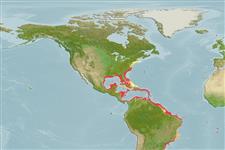>
Perciformes/Scorpaenoidei (Scorpionfishes) >
Scorpaenidae (Scorpionfishes or rockfishes) > Scorpaeninae
Etymology: Scorpaena: Latin, scorpaena = a kind of fish, 1706 (Ref. 45335).
Eponymy: Charles Plumier (1646–1704) was a Franciscan monk, botanist and naturalist. [...] (Ref. 128868), visit book page.
More on author: Bloch.
Environment: milieu / Klimaatzone / Diepte / distribution range
Ecologie
marien rifbewoner; diepte 1 - 70 m (Ref. 126840), usually 5 - 55 m (Ref. 5288). Subtropical; 43°N - 30°S, 98°W - 5°W
Western Atlantic: Bermuda, Massachusetts, and northern Gulf of Mexico to southern Brazil. Eastern Atlantic: Ascension and St. Helena.
Grootte / Gewicht / Leeftijd
Maturiteit: Lm ? range ? - ? cm
Max length : 45.0 cm TL mannelijk / geslacht onbekend; (Ref. 5288); common length : 30.0 cm TL mannelijk / geslacht onbekend; (Ref. 3812); max. gepubliceerd gewicht: 1.6 kg (Ref. 40637)
Dorsale stekels (totaal) : 12; Dorsale zachte stralen (totaal) : 10; Anale stekels: 3; Anale zachte stralen: 5. Occipital pit present; three to four spines on part of preorbital overlapping maxillary; large white spots on dark background on inner basal part of pectoral fin (unclear in specimens smaller than 3 cm SL) (Ref. 13608).
Body shape (shape guide): fusiform / normal.
Found mostly in shallow coral reef and rocky areas. Lies motionless on the bottom (Ref. 9710). Feeds mostly on other fishes and crustaceans. Moderately common below about 5 m depth to at least 55 m. Displays characteristic bright white spots on dark background of pectoral axil when disturbed (Ref. 49392). Anterolateral glandular groove with venom gland (Ref. 57406). Eaten locally and said to taste a bit like chicken. Traded as an aquarium fish at Ceará, Brazil (Ref. 49392).
Levenscyclus en paargedrag
Maturiteit | Voortplanting | Paaien | Eieren | Fecunditeit | Larven
Smith-Vaniz, W.F., B.B. Collette and B.E. Luckhurst, 1999. Fishes of Bermuda: history, zoogeography, annotated checklist, and identification keys. American Society of Ichthyologists and Herpetologists Special Publication No. 4. 424 p. (Ref. 35505)
Status op de Rode Lijst van het IUCN (Ref. 130435: Version 2025-1)
Gebruik door de mens
Visserij: van minder commercieel belang; Aquarium: Commercieel
Tools
Speciale rapporten
Download XML
Internetbronnen
Estimates based on models
Preferred temperature (Ref.
123201): 21.9 - 28, mean 25.6 °C (based on 770 cells).
Fylogenetische diversiteitsindex (Ref.
82804): PD
50 = 0.5000 [Uniqueness, from 0.5 = low to 2.0 = high].
Bayesian length-weight: a=0.01514 (0.00977 - 0.02344), b=2.99 (2.86 - 3.12), in cm total length, based on LWR estimates for this species & Genus-body shape (Ref.
93245).
Trofisch niveau (Ref.
69278): 3.6 ±0.3 se; based on diet studies.
Weerstandsvermogen (Ref.
120179): laag, minimale populatieverdubbelingstijd 4,5-14 jaar (Preliminary K or Fecundity.).
Fishing Vulnerability (Ref.
59153): Low to moderate vulnerability (35 of 100).
🛈
Nutrients (Ref.
124155): Calcium = 26.5 [10.7, 67.5] mg/100g; Iron = 0.53 [0.27, 1.47] mg/100g; Protein = 19.3 [17.6, 21.0] %; Omega3 = 0.293 [0.127, 0.806] g/100g; Selenium = 16.8 [7.9, 40.6] μg/100g; VitaminA = 58.3 [19.9, 179.9] μg/100g; Zinc = 0.815 [0.541, 1.238] mg/100g (wet weight);
